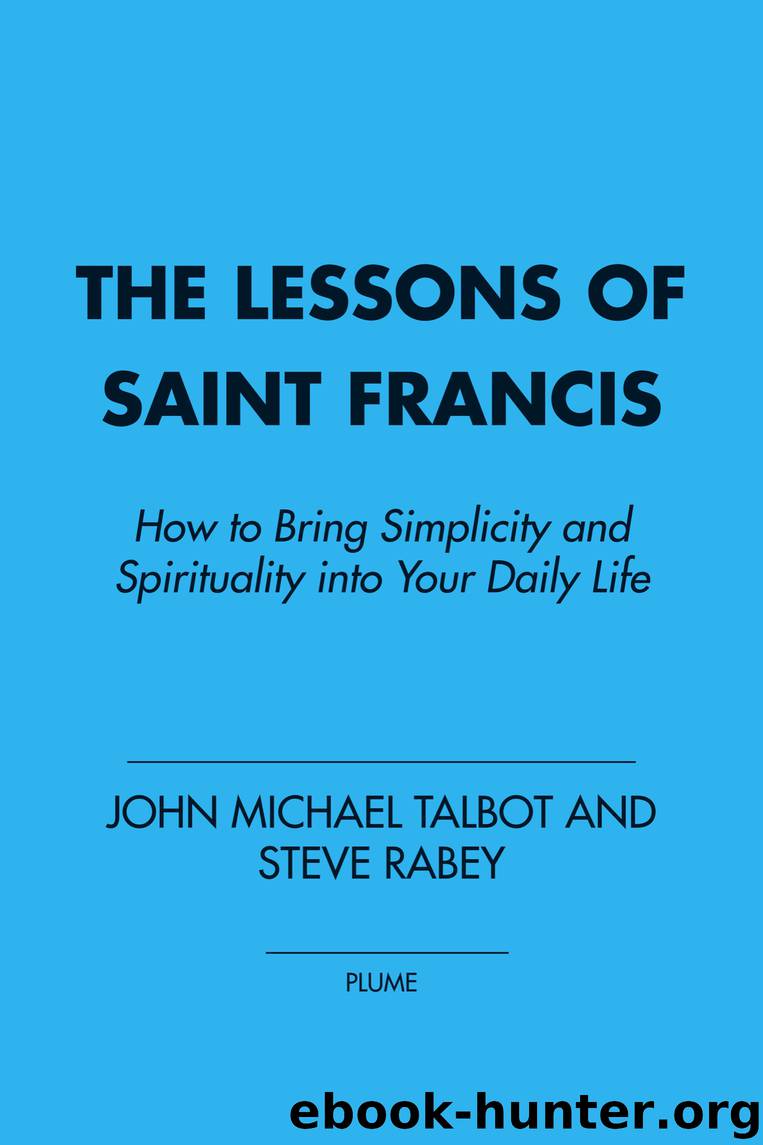The Lessons of Saint Francis by John Michael Talbot & Steve Rabey

Author:John Michael Talbot & Steve Rabey
Language: eng
Format: epub
Publisher: Penguin Publishing Group
Published: 1998-09-30T16:00:00+00:00
In a real sense all life is interrelated. All [people] are caught in an inescapable network of mutuality, tied in a single garment of destiny.
—MARTIN LUTHER KING JR.
In the twentieth century, the Christian religion has been redesigned to accommodate the radical individualism of the West. But we should never forget that Christianity began as a communal faith. Just look at the New Testament’s description of the first followers of Jesus: “All the believers were together and had everything in common. Selling their possessions and goods, they gave to anyone as he had need. . . . And the Lord added to their number daily those who were being saved.”
As the Christian movement grew and matured, and its message spread around the world, this communal dimension waned. Ironically, it was St. Anthony of Egypt, a solitary hermit who fled to the desert to be alone with God in the late third century, who helped revive Christian communalism. People became attracted to the deeply spiritual saint, followed him to his cave in the desert, and formed a community dedicated to spiritual growth and mutual support—creating one of the earliest Christian monasteries.
Christian monasticism became even more popular in the fourth century, after the Roman Empire declared Christianity its official religion. Many believers felt that giving Christianity official status only watered down the faith, so they created communities where they could live out the teachings of Jesus in a purer form.
Twentieth-century monk Thomas Merton described the magnetic allure monasticism held for these early Christian communitarians in his book Wisdom from the Desert : “Society—which meant pagan society, limited by the horizons and prospects of life ‘in this world’—was regarded by them as a shipwreck from which each single individual man had to swim for his life.”
A dizzying variety of Christian communities flourished around the world as spiritually inclined individuals sought havens for holy living. Then, early in the sixth century, St. Benedict of Nursia developed a popular and practical model for monastic living, earning him the title “the father of Western monasticism.” The Benedictine rule, which influenced many monasteries for centuries, stressed prayer, discipline, and labor. During the Middle Ages, monasteries provided an island of silence, solitude, study, and spiritual growth in the midst of an often turbulent world. And they continue to do so today.
In community, people such as myself burrow deep in the fertile soil of fraternity, which allows us to uncover our deep selves and strengthen our faith. Or as Jean Vanier, a twentieth-century Frenchman who has founded more than one hundred L’Arche communities for the physically and mentally handicapped, puts it: “Community is a place of belonging, a place where people are earthed and find their identity.”
For ages, the message of the monasteries has been that Christianity isn’t a solo performance. Instead, each of us is part of an amazing choir, and the mystical music we make together is a beautiful creation, both to us and to God. For me and many others, living in Christian community gives us a chance to join our voices in a universal chorus of brotherhood.
Download
This site does not store any files on its server. We only index and link to content provided by other sites. Please contact the content providers to delete copyright contents if any and email us, we'll remove relevant links or contents immediately.
Resisting Happiness by Matthew Kelly(2886)
The Social Psychology of Inequality by Unknown(2309)
Designing Your Life by Bill Burnett(2265)
Day by Elie Wiesel(2241)
The Giving Tree by Shel Silverstein(1837)
Angels of God: The Bible, the Church and the Heavenly Hosts by Mike Aquilina(1628)
Human Design by Chetan Parkyn(1573)
Augustine: Conversions to Confessions by Robin Lane Fox(1473)
The Supreme Gift by Paulo Coelho(1445)
Hostage to the Devil by Malachi Martin(1396)
7 Secrets of Divine Mercy by Vinny Flynn(1391)
Jesus of Nazareth by Joseph Ratzinger(1376)
Dark Mysteries of the Vatican by H. Paul Jeffers(1341)
The Vatican Pimpernel by Brian Fleming(1340)
Saints & Angels by Doreen Virtue(1311)
St. Thomas Aquinas by G. K. Chesterton(1306)
My Daily Catholic Bible, NABRE by Thigpen Edited by Dr. Paul(1207)
Called to Life by Jacques Philippe(1201)
The Ratline by Philippe Sands(1165)
